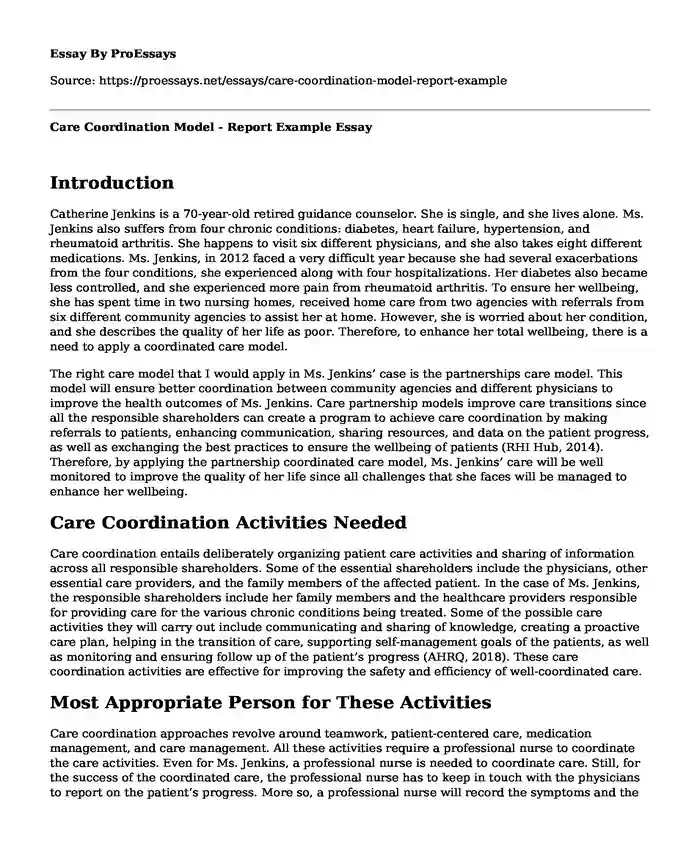Introduction
Catherine Jenkins is a 70-year-old retired guidance counselor. She is single, and she lives alone. Ms. Jenkins also suffers from four chronic conditions: diabetes, heart failure, hypertension, and rheumatoid arthritis. She happens to visit six different physicians, and she also takes eight different medications. Ms. Jenkins, in 2012 faced a very difficult year because she had several exacerbations from the four conditions, she experienced along with four hospitalizations. Her diabetes also became less controlled, and she experienced more pain from rheumatoid arthritis. To ensure her wellbeing, she has spent time in two nursing homes, received home care from two agencies with referrals from six different community agencies to assist her at home. However, she is worried about her condition, and she describes the quality of her life as poor. Therefore, to enhance her total wellbeing, there is a need to apply a coordinated care model.
The right care model that I would apply in Ms. Jenkins’ case is the partnerships care model. This model will ensure better coordination between community agencies and different physicians to improve the health outcomes of Ms. Jenkins. Care partnership models improve care transitions since all the responsible shareholders can create a program to achieve care coordination by making referrals to patients, enhancing communication, sharing resources, and data on the patient progress, as well as exchanging the best practices to ensure the wellbeing of patients (RHI Hub, 2014). Therefore, by applying the partnership coordinated care model, Ms. Jenkins’ care will be well monitored to improve the quality of her life since all challenges that she faces will be managed to enhance her wellbeing.
Care Coordination Activities Needed
Care coordination entails deliberately organizing patient care activities and sharing of information across all responsible shareholders. Some of the essential shareholders include the physicians, other essential care providers, and the family members of the affected patient. In the case of Ms. Jenkins, the responsible shareholders include her family members and the healthcare providers responsible for providing care for the various chronic conditions being treated. Some of the possible care activities they will carry out include communicating and sharing of knowledge, creating a proactive care plan, helping in the transition of care, supporting self-management goals of the patients, as well as monitoring and ensuring follow up of the patient’s progress (AHRQ, 2018). These care coordination activities are effective for improving the safety and efficiency of well-coordinated care.
Most Appropriate Person for These Activities
Care coordination approaches revolve around teamwork, patient-centered care, medication management, and care management. All these activities require a professional nurse to coordinate the care activities. Even for Ms. Jenkins, a professional nurse is needed to coordinate care. Still, for the success of the coordinated care, the professional nurse has to keep in touch with the physicians to report on the patient’s progress. More so, a professional nurse will record the symptoms and the medical history of the patients, administering medications and treatments, perform diagnostic tests, and at the same time, provide support for patients. A professional nurse will also play the role of educating patients on the necessary management of specific conditions as part of coordinated care. For instance, in the case of Ms. Jenkins, a professional nurse will provide insights on the measures that should be taken to control sugar levels in the body and hypertension. Besides, a professional nurse will also educate Ms. Jenkins on managing other chronic conditions that she experiences. Therefore, nurses act as the most appropriate professionals to maintain effective nurse-patient relationships when offering coordinated care.
Priorities for Short, Moderate, and Long-Term Outcomes
The short-term outcome priority for Ms. Jenkins under the coordinated partnership care model includes meeting patient care needs. Ms. Jenkins needs medications and treatment to control her chronic conditions, which has affected the quality of her life. The moderate outcome priority, on the other hand, ensures good communication and successful care transitions between the healthcare providers. After providing the essential needs for Ms. Jenkins, some care transitions are expected, which implies a need for effective communication to understand the care transitions. Finally, the long-term outcome includes ensuring the total recovery of the patient through constant follow up. The priority in the long term is to ensure total recovery for Ms. Jenkins, and it will be facilitated by effective management of medications and treatment along with follow-ups to ensure her wellbeing.
Conclusion
Ms. Jenkin requires coordinated care to ensure her wellbeing. The partnership care model will work effectively to ensure her total recovery and wellbeing because it will enhance effective communication and care plan transitions to enhance the quality of her life. The partnership model will also ensure effective follow up to improve Ms. Jenkins’ health. Some of the common activities under this partnership care coordination model include communicating and sharing of knowledge among the healthcare professionals, creating a proactive care plan, helping in the transition of care, as well as monitoring and ensuring follow up on the patient’s progress.
References
AHRQ. (2018, August). Care Coordination. Department of Health and Human Services. https://www.ahrq.gov/ncepcr/care/coordination.html
RHI Hub. (2014. February 13). Partnerships Model. Rural Health Information Hub.
https://www.ruralhealthinfo.org/.
Cite this page
Care Coordination Model - Report Example. (2023, Dec 12). Retrieved from https://proessays.net/essays/care-coordination-model-report-example
If you are the original author of this essay and no longer wish to have it published on the ProEssays website, please click below to request its removal:
- Dissertation on Tunisian Cultural Identity in Cinema After the Rise of the Arab Spring's Protest
- Paper Example on Rachel Dolezal's Identity and Culture
- HIPAA Privacy Rule: Standards for Protecting Patients' Data - Essay Sample
- Essay Example on Elevating My Literacy: An Editor, My Parents, and Me
- Essay Example on Nurse Practitioners: A Comprehensive Overview of Scope of Practice
- Essay Sample on Forgotten: Examining Long-Term Memory Loss & Repressed Memories
- Analyzing "A Heart Worn on My Hand" - Free Paper Example







